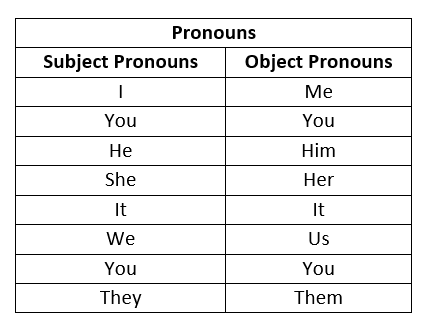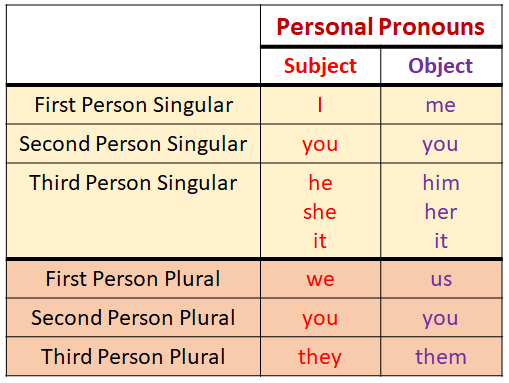Personal Pronouns
Related Pages
Types of Pronouns
Relative Pronouns
Possessive Pronouns
Subject Pronouns, Object Pronouns, Reflexive Pronouns
More Lessons On English Grammar
In these lessons, we will learn personal pronouns, subject pronouns and object pronouns and how to use them.
A pronoun is a word that takes the place of a common noun or a proper noun.
The words I, you, he, she, it, we and they are called personal pronouns. They take the place of words for people, animals, places or things.
Examples:
Mona is five years old.
She is five years old. (She replaces Mona)
Jerry bought a new car.
He bought a new car. (He replaces Jerry)
James and Tom are going home.
They are going home. (They replaces James and Tom)
The vase is broken.
It is broken. (It replaces the vase)
The following table gives the subject pronouns and object pronouns. Scroll down the page for examples on how to use the pronouns.

Subject Pronouns
In the following examples, the personal pronoun is used as the subject of the sentences. The subject is the person, animal or thing that does the action shown by the verb. The words I, you, he, she, it, we and they are called subject pronouns.
Examples:
He has bought an ice cream. (He is the subject pronoun and bought is the verb)
She works in the bank. (She is the subject pronoun and works is the verb)
They went to the playground. (They is the subject pronoun and went is the verb)
Object Pronouns
The words me, you, him, her, it, us and them are also personal pronouns for people, animals, places or things. They are called object pronouns. The object pronoun is used as the object of the verb. It is the person, animal or thing that receives the action shown by the verb.
Examples:
Can you please give the things to me? (The object pronoun is me and give is the verb)
Everyone is looking for her. (The object pronoun is her and looking is the verb)
Tell them to be careful. (The object pronoun is them and tell is the verb)
Personal Pronouns
Personal pronoun can be classified as:
-
first person
(which refers to the person speaking): I, we -
second person
(which refers to the person being spoken to): you -
third person
(which refers to the person being spoken about): he, she, it, they
The following diagram shows a summary of the personal pronouns. Scroll down the page for more examples and solutions on how to use personal pronouns.

Videos
English Vocabulary – Personal Pronouns
ESL video – Pronouns (Elementary Level)
Examples:
I, You, He, She, It, We, You, They
Subject Pronouns and Object Pronouns
The difference between subject and object pronouns
Try out our new and fun Fraction Concoction Game.
Add and subtract fractions to make exciting fraction concoctions following a recipe. There are four levels of difficulty: Easy, medium, hard and insane. Practice the basics of fraction addition and subtraction or challenge yourself with the insane level.

We welcome your feedback, comments and questions about this site or page. Please submit your feedback or enquiries via our Feedback page.